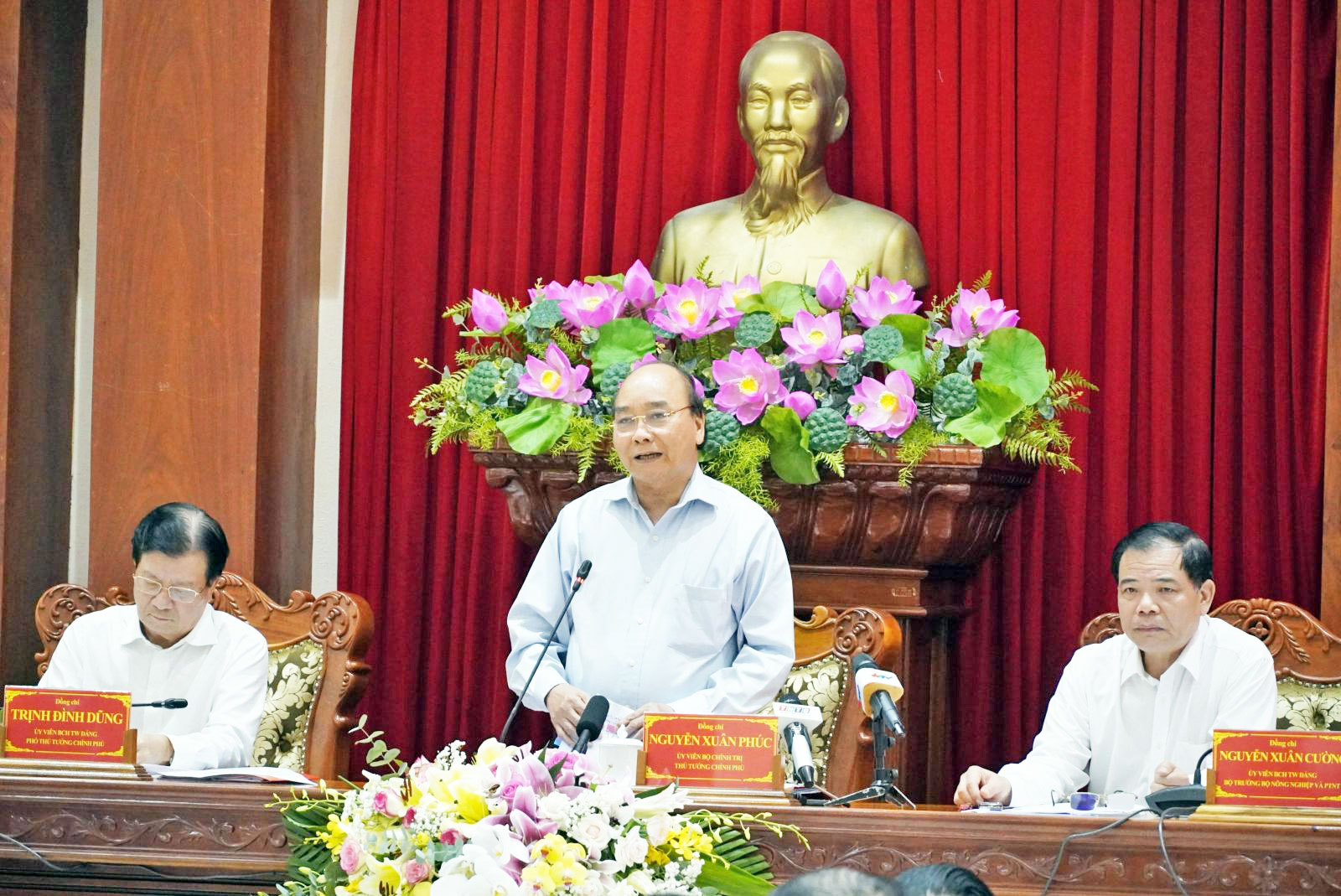
PM - Nguyen Xuan Phuc asked localities to actively store water right from the rainy season to limit the damage caused by drought and salinity
On September 23, in Tien Giang province, Prime Minister - Nguyen Xuan Phuc had a working session with ministries, branches and 13 provinces and cities in the Mekong Delta on proactive measures to cope with drought and saltwater intrusion in the dry season. Vice Chairman of the Provincial People's Committee - Pham Van Canh attended the event for Long An province.
The National Center for Meteorological and Hydrological Forecasting informed that the total cumulative rainfall in the Mekong basin since the beginning of the rainy season is 25 - 45 percent lower than the average of many years. Enso phenomenon has the ability to transition into La Nina state at the end of the year with a probability of 65 - 70 percent.
Therefore, the rain tends to increase, in addition, from now to the end of the year, it is forecasted that 4 - 5 storms will appear in the Central and the South, causing heavy rain in the Mekong basin. The water shortage in the Mekong basin can be offset by late rainfall, however, the rainfall is likely to be 5-15 percent lower than the average for many years.
The Mekong Delta has 95 percent of the total water from the upper Mekong, this water source plays a important role in the saline intrusion in the delta. Since the beginning of the rainy season up to now, the runoff in the Mekong basin has been at very low level due to the lack of rainfall.
The water level on the Mekong mainstream on September 19 at Chiang Sean station (bordering China, more than 2,000 kilometers from Tan Chau station, Vietnam) was at 3.44 meters, 1.92 meters lower than the average for many years. Water level at Kratie station (300 kilometers from Tan Chau station) is at 12.1 meters, 6.76 meters lower than the average of many years.
The total amount of water in the flood season this year up to now is the lowest in history, at Kratie station about 91.9 billion cube meters, lower than the average of 106.5 billion cube meters for many years. The lake in Cambodia is nearly 77 percent lower than the average for many years.
According to the Ministry of Natural Resources and Environment, this year's flood peak in the Mekong upstream is likely to be lower than the alarm level 1, at Tan Chau 3.5 meters, Chau Doc, appearing late in mid-October. However, the risk of rapid flooding due to short-term heavy rains may appear. Due to low floods, saline intrusion in the southern river mouth will come sooner, more severe than the average of many years, but less likely to be more serious than the dry season 2019.
Accordingly, in the worst scenario, saline intrusion can be severe to very serious, equivalent to 2019. At the Mekong estuaries, the salinity boundary will be 4 grams per liter, the highest is 65 - 75 kilometers, and 20 - 30 kilometers compared to the average of many years, 3 - 5 kilometers higher than in 2016, some times equivalent to 2019. About 98,000 hectares of Winter-Spring rice crop in the provinces of Soc Trang, Tra Vinh, Tien Giang, Ben Tre, Long An, Ca Mau is at risk of being affected. In addition, 82,000 hectares of fruit trees may also be affected, about 76,000 households lack drinking water.
At the conference, a number of provinces such as Tien Giang proposed the central government support to complete the dam system to prevent salinity in the vicinity of Long An, considering the plan to build temporary dams on Ham Luong river (Ben Tre povince) in the salinity drought season of to limit salinity encroachment into this province.
Ca Mau province also presented that because it did not receive water from the Mekong, the main source of fresh water was from rainwater and underground water. Because underground water has been banned from exploitation, it is necessary to soon build a large-scale freshwater reservoir to actively accumulate water in the dry season.
Prime Minister - Nguyen Xuan Phuc said that the drought caused many difficulties for life and production in the Mekong River Delta in 2016 and 2019. This year's salinity drought is forecast to be more fierce than in 2016, so ministries, branches and localities need immediate and long-term measures to minimize losses, ensure people's lives, and improve efficiency of agricultural production in this area.
"We are in the rainy season, so we need to actively discuss measures to build dams and store fresh water for the dry season right now, especially fresh water sensitive crops such as durian", PM Nguyen Xuan Phuc said.
PM also asked localities to ensure clean water for the people, not to lack of fresh water. In addition, it is necessary to discuss reducing the area of Winter-Spring rice crop to minimize risks, as well as continue implementing irrigation works to prevent salinity and make water fresh in the delta. Although the Government's policy is favorable, it also needs hardening works to limit saline intrusion deep into the delta. In addition, localities discussed and researched suitable plant varieties to convert in new conditions.
This year, the drought and salinity lasted for more than 6 months, causing 6 provinces: Ben Tre, Tien Giang, Long An, Kien Giang, Ca Mau and Soc Trang to announce an emergency saline situation. The drought and salinity caused 43,000 hectares of rice loss, 80,000 households lacked water for daily use. The Government has spent 530 billion VND for the provinces to respond./.
By Chau Son – Translated by Duc Tam
Source: http://baolongan.vn/thu-tuong-nguyen-xuan-phuc-yeu-cau-tru-nuoc-chong-han-man-ngay-tu-mua-mua-a102899.html
 Vietnam on track to rank among world’s 30 largest economies
Vietnam on track to rank among world’s 30 largest economies



